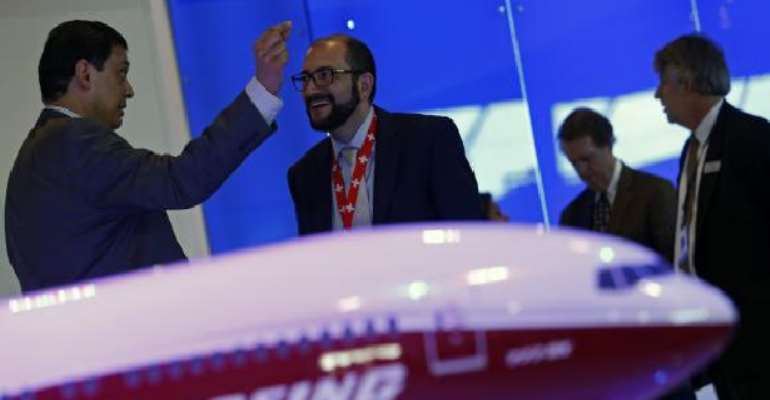New Boeing Jets Hold Key To More Than Half Of Future Sales

Boeing Co (BA.N) said it expects to finish flight testing its stretched 787-9 Dreamliner in the next two months and deliver it around mid-year, one of six new jets the world's biggest plane-maker aims to get into service by the end of the decade.
Boeing will start fabricating parts for its 737 MAX jetliner this year, keeping that new development program on course for final assembly to start by mid-2015 and service entry in 2017, company officials said in media briefings made public late on Wednesday.
The company also is 'well along' in choosing suppliers for its 777X wide-body jet, due to enter service in 2020, though officials would not elaborate on the extent of selection.
The three jets are part of a major overhaul of Boeing's product lines that is 'harvesting' technology and lessons from the its original high-tech 787 Dreamliner and adding efficient new engines to make 737 and 777 models that burn less fuel, fly more easily and provide passengers with more comfort.
Chicago-based Boeing is fiercely competing with new models from European rival Airbus Group NV (AIR.PA) to capture its share of a world jetliner market estimated at $4.8 trillion over the next 20 years.
The three jetliner families will account for more than half of Boeing's commercial plane sales over 20 years, said Scott Fancher, senior vice president for airplane development.
'What we have in work today really is the future of Boeing Commercial Airplanes,' he said.
Boeing is redesigning the 777X and 737 MAX cockpits to make them mirror the 787 design, including larger displays and other features, making it easier for pilots to move from one aircraft type to another and reducing airline costs.
Boeing said it will seek a common pilot type certification for the 777-300ER, the 787 and the 777X, allowing pilots to fly all three aircraft with as little as five days of additional training.
Here are capsule summaries of the status of the three programs:
787-9 and 787-10
Boeing said the Hybrid Laminar Flow Control system on the tail fin and horizontal stabilizer of the 787-9 produced 'significant' reduction in aerodynamic drag in testing, but the company declined to be specific. Boeing plans to use HLFC on the 787-10 but has not decided if it is worth putting on future 787-8 models, said Ed Petkus, deputy chief project engineer for 787 airplane development.
Fancher said Boeing assembly lines in North Charleston, South Carolina and Everett, Washington, would provide flexibility about where to assemble 787-9 and 787-10s, although he declined to say if North Charleston would build either model.
The 787-10, which is undergoing detailed design, will cost 10 percent less to operate than the Airbus A350-900 on a per-seat basis and will have at least 26 more seats, said Jim Haas, Boeing's director of product marketing.
Airbus said in response that the A350 offers 6 percent better fuel efficiency than the current 787-8.
737 MAX
While still under development, the 737 MAX is 'meeting or exceeding our performance targets,' including 8 percent lower fuel consumption than the Airbus A320neo on a per-seat basis, when configured with 12 more seats, said Keith Leverkuhn, 737 MAX general manager.
Boeing said it will build the air inlet for the engine itself, capturing what is typically a high profit-margin component. The current supplier of part is United Technologies(UTX.N).
The production will be 'highly automated and done in South Carolina,' Leverkuhn said.
The Airbus A320neo family was launched nearly a year before the 737 MAX, and has garnered about 58 percent of total single-aisle sales of the two jets. But Boeing says the 737 MAX has outsold its rival since coming to the market, garnering about 55 percent. Currently, Airbus has firm orders for 2,667 A320neos versus 1,939 for the 737 MAX.
Boeing said the 737 MAX will be 14 percent more efficient that its current 737. It said 11 percent of the gain comes from the engine and airframe combination, and the rest from aerodynamic improvements. The jet is due to enter service in the third quarter of 2017, Leverkuhn said.
In designing the MAX, Boeing is trying to retain the jet's high reliability and also make it easy to build, because even as the company introduces the new MAX version, it plans to raise the production rate to 47 a month in 2017 from 42 a month currently.
777X
Design of the 777X, a new version of Boeing's top-selling widebody jet, is 'very stable,' Fancher said.
The design will try to replicate the low noise, higher humidity and higher cabin pressure of the composite-body 787 in the aluminum fuselage of the 777. Boeing also wants to keep the reliability of the 777.
While Boeing continues to refine the 777X in response to customer requests, the company is 'not seeing any major configuration changes that would disrupt the development or put risk on the schedule,' he said.
Boeing is trying to get the plane certified under an amended type certificate of the current 777, rather than as a new design. The Wall Street Journal reported late Wednesday that the Federal Aviation Administration said it had agreed to Boeing's request.
Boeing did not respond to a request for comment and FAA could not immediately be reached for comment.
Boeing says the 777-9X will have 10 percent lower cost per seat than the A350-1000, will carry more than 50 more passengers and will have more range.
Boeing is widening the interior of the cabin by about 4 inches at passenger level by whittling structural frames in the fuselage. That will allow seats to be about two-tenths of an inch wider in 10-abreast configuration, Haas said.
The 777X may be renamed as the 797 and may get a name like the Dreamliner did. But Haas would not be drawn on what that might be.
REUTERS
